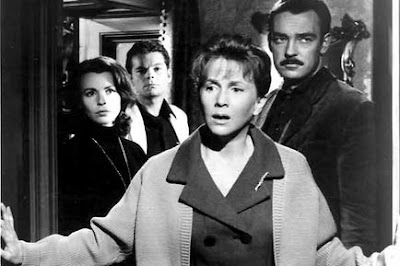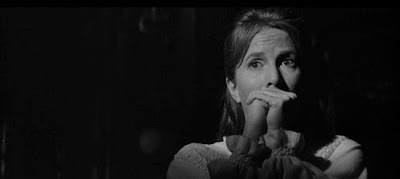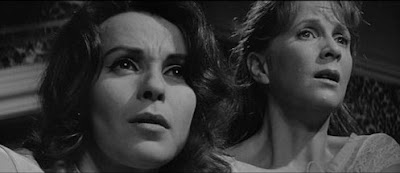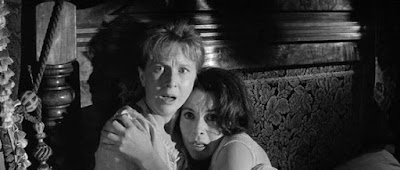Producer/director Roger Corman's biggest critical and commercial successes were his moody adaptations of Edgar Allan Poe classics for American International Pictures. Starting with 1960's House of Usher and 1961's The Pit and the Pendulum, the series elevated Corman's status as a filmmaker of skill and economy, and permanently engraved Vincent Price's face on horror cinema's Mt. Rushmore.
After the first handful of these, everyone agreed that it was time to lighten up and have some fun. Corman had directed comedy already, a low-low-budget mock-horror film with Jack Nicholson, 1960's Little Shop of Horrors. In '62 he teamed up Price with Peter Lorre and Basil Rathbone in a Poe anthology film, Tales of Terror, where he again revealed a light touch. For The Raven in '63, he went for outright whimsy in a giddy spoof that brought together Price, Lorre, Boris Karloff, and Nicholson. The following year saw Corman casting Price, Lorre, Karloff, and Rathbone in Comedy of Terrors.
Both The Raven and Comedy of Terrors took advantage of the gothic look of the "AIPoes" courtesy of Corman's in-house designer Daniel Haller and photographer Floyd Crosby. Also carried over was screenwriter Richard Matheson. These once-over-slightly comedies are the very definition of "lightweight" and feel aimed more at kids than ostensible grownups. But they show off a screwball side of their heavyweight castmembers, who were all naturally gifted at comic shenanigans. As Matheson says on a supplement filmed for MGM's "Midnite Movies" two-fer disc, "no one realizes how these so-called 'scary actors', how funny they could be."
These titles offered no pathbreaking contributions to either horror or comedy cinema, but they do serve as a pair of mints before we dig into the best of Corman's richer fare, The Masque of the Red Death ('64) and The Tomb of Ligeia ('65).
 Entertaining fluff, The Raven takes Poe's most famous poem and doesn't so much adapt it as dress it up in a clown nose and silly hat. It puts a cartoon spin on Corman's melodramatic Grand Guignol Poe style while sending up its stars' status as the "Titans of Terror."
Entertaining fluff, The Raven takes Poe's most famous poem and doesn't so much adapt it as dress it up in a clown nose and silly hat. It puts a cartoon spin on Corman's melodramatic Grand Guignol Poe style while sending up its stars' status as the "Titans of Terror."Price is Dr. Erasmus Craven, a retired sorcerer mooning over the death of his wife Lenore two years earlier. As he gloomily recites Poe's lines of lamentation, a raven flies into the room. The raven is talky and obnoxious — "Will I ever see my lost Lenore?" the wizard entreats, "How the hell should I know?" quoth the bird — and some hocus-pocus turns it into pudgy Dr. Bedlo (Lorre). A low-rent conjurer, Bedlo reports that he'd been turned into a raven by rival sorcerer Dr. Scarabus (Karloff), and that at Scarabus' castle he saw a woman who looks like Lenore.
Craven and Bedlo ride to Scarabus' castle to investigate. They're accompanied by Craven's daughter (Olive Sturgess) and her boyfriend, who's also Bedlo's son, played with gee-whiz boyishness by Jack Nicholson, who was all of 26 but looked 18. Even when he's under the thrall of Scarabus' "diabolical mind control," it's hard to shake the cognitive dissonance of Jack freakin' Nicholson posing like Batman's Burt Ward in a castoff Ren Fair costume. (His scene with Lorre at movieclips.com clues us in that the Jack we'd come to know five years later in Easy Rider and beyond is nascent there in his voice.)
This past May, at a Vincentennial film fest, Corman spoke about his experiences collaborating with Price, and mentioned that during the shooting of The Raven the gracious elder-statesman actor was generous about mentoring his young colleagues such as Nicholson. Jeff Owens at downrightcreepy.com caught on video Corman's 45-minute chat with Video Watchdog editor Tim Lucas, and it's well worth a look for his memories of the whole Poe-Price series. Once again it reminds me that Corman, now 85, has always struck me as Hollywood's most good-natured, unaffected, and approachable long-time honcho.
At Cinefantastique Online, in another centennial celebration of Price, Corman recalls that...
On the set of THE RAVEN, Vincent had to adjust to the presence of two veteran co-stars, Peter Lorre and Boris Karloff, as well as a new young actor, Jack Nicholson. He showed extraordinary flexibility in working harmoniously with Jack (trained in the Method), Boris (schooled in the English classical style) and Peter, who did anything that came into his mind at any given moment!
Peter Lorre's great talent was for improvising, which he did with great wit and panache. This on-the-set spontaneity did not sit well with Boris Karloff who was nearing the end of a long and distinguished career, and expected to do his scenes precisely as written. Inevitably, there was some friction between these two strong personalities. Fortunately for me, Vincent was able to strike a balance in his own acting style, adapting to Peter’s looseness but also playing scenes with Boris that were models of the classical approach. His personal graciousness in bending to the demands of two conflicting egos was a great help to me in what could have been difficult circumstances.
It turns out that "lost" Lenore (Hazel Court, of established cleavage fame) faked her death to take up with wealthy and powerful Scarabus. Craven's confrontation with his rival escalates to an elaborately staged duel of wizardly magic that's wrought with colorful and precision-ridiculous special effects:
I suspect that when their old colleagues at Hogwarts hold a class reunion, the invitations for these two are always inexplicably "lost in the mail."
The Raven is pleasurable in a Saturday-morning-with-a-bowl-of-Fruit-Loops sort of way, and isn't much more substantial than the sugar-tinted milk left in the bowl. But one of its pleasures is the clarity that its cast is having a relaxed, high old time. Karloff has more presence here than in Comedy of Terrors, and proves again why he was the one true voice of the Grinch. For his part, there's a time or two when Price looks ready to crack up giggling from the goof he's having.
Corman was always a master of the bottom line. Because he brought the film in ahead of schedule, under budget, and with three days left on Karloff's contract, he shot another quickie with Karloff and Nicholson on the same sets, The Terror, a precursor of Peter Bogdanovich's first film, Targets.
 Comedy of Terrors has no connection to Poe, direct or tenuous, though it still tends to get placed under the Corman-Poe flag because ... well, by this point because why the hell not?
Comedy of Terrors has no connection to Poe, direct or tenuous, though it still tends to get placed under the Corman-Poe flag because ... well, by this point because why the hell not?In this outing, unscrupulous undertaker Price realizes that business needs a pick-up. Aided by his put-upon assistant Lorre, he connives to boost demand by sneaking into the bedrooms of wealthy old men and smothering them in their sleep, then being on hand to manage funeral arrangements (which includes re-using coffins) when the relatives arrive. Price hits some heretofore new funny-nasty strides when verbally abusing his opera-screeching wife, Joyce Jameson, and her dotty old codger father, Karloff.
Basil Rathbone takes an appropriately hammy spin as the Shakespeare-spouting landlord. After he comes to Price demanding the past year's rent, the film occupies itself with Price trying time and again to do in Rathbone, who won't stay dead even when laid out at his own burial service.
Everyone here is good fun to watch playing against type. Karloff is a snoozy old duffer who burbles on about historical funereal rites; Price's villainy is spiky and booze-soaked rather than his usual silky and genteel; and 60-year-old Lorre, of all people, gets to be the love interest. Price and Lorre refine the Laurel and Hardy duo begun in The Raven, a pairing that might have had real legs if they'd kept it up for more films.
 Clearly it takes two actresses to make up for the lack of Hazel Court. This time stripper Beverly Powers ("Miss Beverly Hills") makes her screen debut as the amply cleaved widow Mrs. Phipps. Unlike Jack Nicholson's, hers was not a long career that found a start with Corman, with later titles such as Brides of Blood and The Island of Living Horror just not conveying that Academy-attracting je ne sais quoi. Casting both Powers and Joyce Jameson in the film for identical reasons (two actresses, four parts, so to speak) guaranteed repeat business from 15-year-old boys who'd tell their parents they were headed to the matinee for just a harmless comedy.
Clearly it takes two actresses to make up for the lack of Hazel Court. This time stripper Beverly Powers ("Miss Beverly Hills") makes her screen debut as the amply cleaved widow Mrs. Phipps. Unlike Jack Nicholson's, hers was not a long career that found a start with Corman, with later titles such as Brides of Blood and The Island of Living Horror just not conveying that Academy-attracting je ne sais quoi. Casting both Powers and Joyce Jameson in the film for identical reasons (two actresses, four parts, so to speak) guaranteed repeat business from 15-year-old boys who'd tell their parents they were headed to the matinee for just a harmless comedy.On the other hand, that's indeed venerable Joe E. Brown (who got the last word in Some Like It Hot) in a memorable bit as a crypt keeper.
There's some fine comic interplay, and this time Corman hired genre-shaping director Jacques Tourneur (Cat People, Night of the Demon) to keep it all looking good and moving forward. And once again versatile composer Les Baxter proves that he can adjust to fit along with the rest of Corman's band of brothers.
Nonetheless, this is an 84-minute film spun from 42 minutes worth of material. If you've seen Neil Simon's Murder by Death you're already familiar with the tone here, and before long the experience alternates between enjoying some funny bits and checking the Time Remaining clock.
MGM's "Midnite Movies" double-feature disc delivers both films in their original 2.35:1 widescreen. They look marvelous. Each shows off rich color and nearly flawless prints. Audio comes in DD 2.0 monaural that's perfectly strong and clear. The Raven has some moments when the audio suddenly becomes a bit noisier and less robust, as if it's from a different source print, but it's nothing serious.
MGM sauced its Corman Poe discs with extras. Here that includes a two-part featurette made in 2003, Richard Matheson: Storyteller, which points the camera at the prolific and self-described "offbeat" screenwriter/novelist, who fondly praises the cast, Corman, and Tourneur, and waxes philosophical about writing and the Nature of Being. Another mini-docu, illustrated with behind-the-scenes shots, is Corman's Comedy of Poe: The affable Corman discusses The Raven's conception and development, as well as working with Nicholson, and notes that it's one of his personal favorite films.
Music: Nina Simone, "Pirate Jenny"
Near at hand: The World of Christopher Marlowe by David Riggs






























